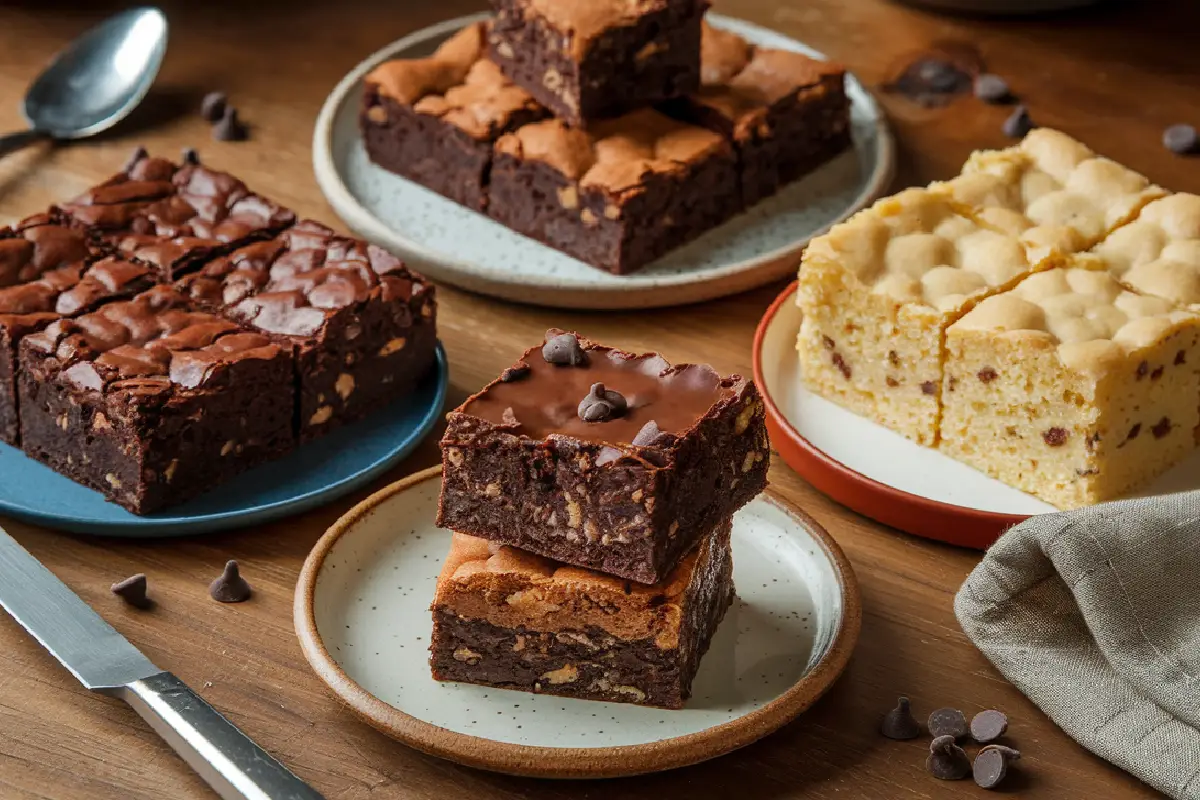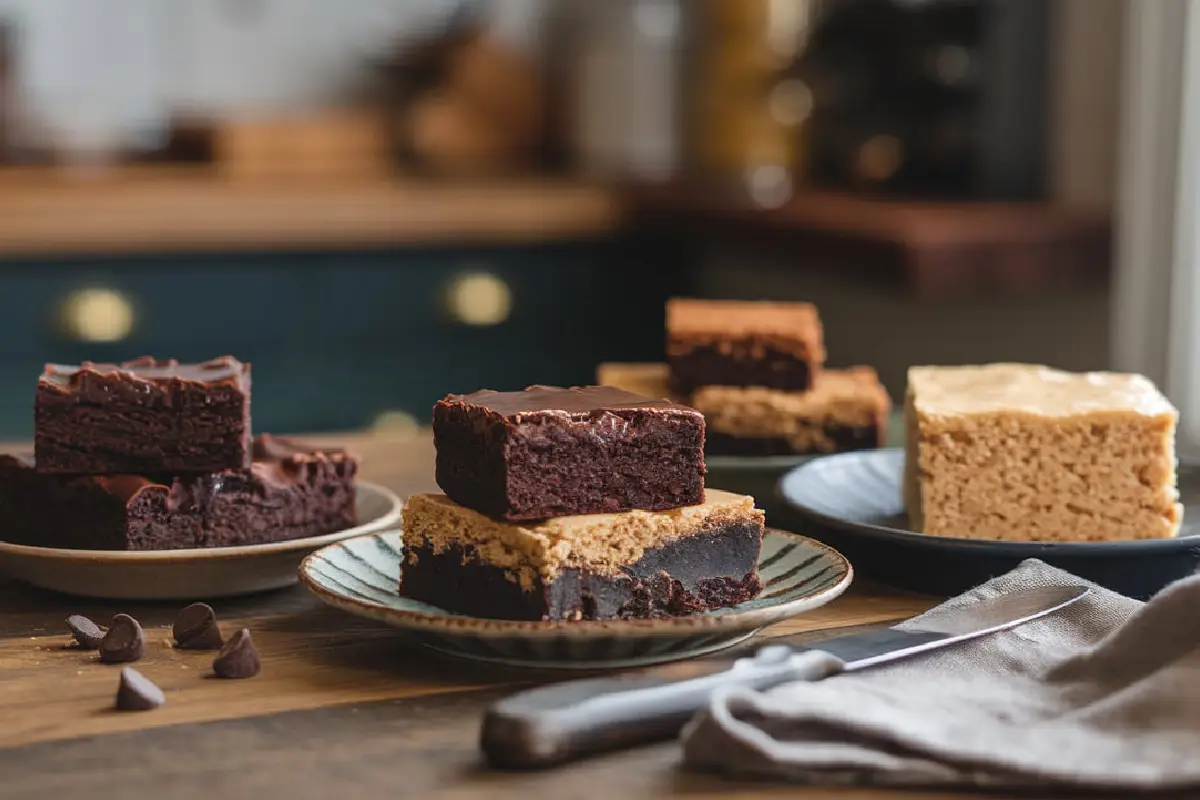Introduction to The Three Types of Brownies
Brownies are a beloved dessert, celebrated for their rich, chocolatey flavor and their versatility. Whether you’re a fan of a dense, fudgy bite or a light, cake-like texture, there’s a brownie for everyone. The main types of brownies—fudgy, chewy, and cakey—each offer unique characteristics that appeal to different tastes. Understanding what sets these brownies apart can help you master your preferred type and even experiment with variations to suit any occasion.
For more insights into the differences in brownie textures, you can explore detailed guides like The Difference Between Fudgy, Chewy, and Cakey Brownies. Similarly, the Real Simple guide offers practical tips for achieving each type of brownie texture.
1. Fudgy Brownies
The first type of the three types of brownies:
Fudgy brownies are the epitome of indulgence, characterized by their dense, moist, and rich texture. They closely resemble the texture of a chocolate truffle, offering an ultra-decadent experience. The secret to their fudginess lies in the balance of high fat content with minimal flour, along with the right combination of chocolate and butter.
-
Key Characteristics:
- Dense, moist, and rich with an almost gooey center.
- Intense, deep chocolate flavor.
- A shiny, crackled top that adds visual appeal and texture.
-
Ingredients:
- High amounts of butter and chocolate are essential for a fudgy texture.
- Minimal flour keeps the brownies dense and prevents them from becoming cakey.
- Eggs provide structure and help bind the ingredients together.
- Granulated sugar contributes to the crackly top and balances the chocolate’s bitterness.
-
Baking Techniques:
- Melt the butter and chocolate together gently, using a double boiler or microwave in short intervals to avoid scorching the chocolate.
- Fold in the dry ingredients gently to avoid incorporating too much air, which could make the brownies cakier.
- Avoid overbaking by checking the brownies a few minutes before the suggested baking time. A toothpick inserted should come out with moist crumbs, not clean.
-
Additional Tips for Perfect Fudgy Brownies:
- Use Espresso Powder: Adding a teaspoon of espresso powder can intensify the chocolate flavor without making the brownies taste like coffee.
- Experiment with Different Types of Chocolate: Dark chocolate adds depth, while milk chocolate can make the brownies sweeter and less intense.
- Let Them Rest: Allowing brownies to rest overnight can enhance their fudgy texture as they continue to set and develop flavor.
-
Popular Variations:
- Truffle Brownies: Incorporate extra chocolate chunks for an ultra-rich experience.
- Nutty Fudgy Brownies: Add toasted nuts like walnuts or pecans for a crunchy contrast.
- Salted Caramel Fudgy Brownies: Swirl in salted caramel before baking for a sweet and salty twist.
-
Pros and Cons:
- Pros: Deeply satisfying and rich, ideal for true chocolate lovers.
- Cons: Can feel too heavy for those who prefer lighter desserts.
2. Chewy Brownies
Chewy brownies are perfect for those who enjoy a satisfying bite that isn’t overly dense or overly airy. They strike a middle ground, with a balanced texture that’s ideal for mix-ins like chocolate chips or nuts. The key to chewy brownies lies in the use of brown sugar and a slightly higher flour ratio, combined with the right baking techniques.
-
Key Characteristics:
- Chewy, dense texture with slightly crisp edges.
- Balanced chocolate flavor that isn’t as intense as fudgy brownies.
- The center is slightly more set than a fudgy brownie, offering a pleasant bite.
-
Ingredients:
- Brown sugar adds moisture and contributes to the chewy texture due to its molasses content.
- Extra egg yolks add richness and elasticity, making the brownies chewier.
- A mix of butter and oil can add both flavor and moisture, contributing to the chewy texture.
-
Baking Techniques:
- Use a metal baking pan for even heat distribution, which helps achieve the perfect chewy consistency.
- Cool the brownies completely in the pan before cutting. This allows the brownies to firm up and enhances the chewiness.
- Avoid overmixing the batter to maintain the chewy texture; mix just until the ingredients are incorporated.
-
Additional Tips for Perfect Chewy Brownies:
- Chill the Batter: Letting the batter chill for 30 minutes before baking can help the flavors develop and improve the texture.
- Use High-Quality Vanilla Extract: A good vanilla extract can enhance the overall flavor and balance the richness of the chocolate.
- Line the Pan with Parchment Paper: This helps remove the brownies easily and keeps the edges from becoming too crisp.
-
Popular Variations:
- Blondies: Swap the chocolate for vanilla to create a chewy, caramel-like bar.
- Chocolate Chip Chewy Brownies: Add chocolate chips or chunks to the batter for extra bursts of chocolate.
- Peanut Butter Swirl Brownies: Swirl peanut butter into the batter before baking for a deliciously chewy and nutty variation.
-
Pros and Cons:
- Pros: Offers a satisfying bite with a balanced texture, perfect for mix-ins.
- Cons: Lacks the intense richness of fudgy brownies, which some chocolate lovers may miss.
3. Cakey Brownies
The third type of the three types of brownies Cakey brownies are light, airy, and more like a chocolate cake in brownie form. They are perfect for those who enjoy a fluffy dessert with a soft, tender crumb. Cakey brownies achieve their texture through a higher ratio of flour and the addition of a leavening agent like baking powder or baking soda.
-
Key Characteristics:
- Light and airy with a fluffy, tender crumb.
- A milder chocolate flavor compared to fudgy brownies.
- Springy texture that bounces back when touched.
-
Ingredients:
- Flour provides structure and gives the brownies their cakey texture.
- Baking powder or baking soda adds lift, making the brownies rise and giving them a cake-like crumb.
- Butter provides flavor, while the use of oil can keep the brownies moist without making them dense.
-
Baking Techniques:
- Cream the butter and sugar before adding the eggs and dry ingredients. This process incorporates air into the batter, giving the brownies their lift.
- Use a whisk to mix the dry ingredients well before adding them to the wet ingredients to ensure even distribution of the leavening agent.
- Bake in a preheated oven and check doneness with a toothpick; it should come out clean or with a few moist crumbs.
-
Additional Tips for Perfect Cakey Brownies:
- Use Room Temperature Ingredients: This helps everything combine smoothly, creating a uniform texture.
- Avoid Overmixing: Mix the batter just until the dry ingredients are incorporated to avoid tough brownies.
- Add a Frosting or Glaze: Since cakey brownies are lighter, they pair well with frostings or glazes, like the fudge frosting from the Fantasy Fudge Recipe.
-
Popular Variations:
- Brownie Cupcakes: Bake the batter in muffin tins for individual servings.
- Spiced Cakey Brownies: Add cinnamon, nutmeg, or even chili powder for a unique twist.
- Frosted Cakey Brownies: Top with a simple chocolate ganache or cream cheese frosting for added sweetness.
-
Pros and Cons:
- Pros: Light and fluffy, easy to make, and pairs well with various toppings.
- Cons: Can be too dry if overbaked and lacks the richness of denser brownie types.
Comparing Fudgy, Chewy, and Cakey Brownies

Understanding the differences between these brownie types can help you choose the perfect one for any occasion:
- Fudgy brownies are dense and intensely chocolatey, ideal for those who want a rich, almost truffle-like experience.
- Chewy brownies strike a balance with a satisfying bite, making them great for incorporating mix-ins like nuts, chocolate chips, or caramel.
- Cakey brownies are light and airy, perfect for those who enjoy a dessert that feels more like cake but still has the chocolatey goodness of a brownie.
Tips for Customizing Your Brownies
- Experiment with Mix-Ins: Brownies are versatile and can be customized with endless mix-ins. Add nuts, chocolate chunks, dried fruit, or even marshmallows to enhance the flavor and texture of your brownies.
- Adjust Sweetness Levels: If you find brownies too sweet, reduce the sugar slightly. Alternatively, for an extra sweet treat, top with powdered sugar, a drizzle of chocolate, or a layer of frosting.
- Try Different Pans: The type of pan you use can affect the texture of your brownies. Metal pans tend to create crispier edges, while glass or ceramic pans bake more evenly but might take a bit longer.
FAQs About The Three Types of Brownies
-
What is the difference between fudgy and cakey brownies?
Fudgy brownies are dense with a high fat content, while cakey brownies are light and airy due to more flour and leavening agents. -
Why are my brownies too dense or too dry?
Brownies can turn out dense if overmixed or if the recipe includes too much fat. Dry brownies may result from overbaking or insufficient moisture. -
Can I modify a recipe to change the texture?
Yes, adjusting the ratios of fat, flour, and sugar, as well as tweaking the baking time, can significantly alter the texture. -
Which type of brownie is best for adding mix-ins like nuts or caramel?
Chewy brownies are usually best for mix-ins as their texture supports additional ingredients without becoming too heavy or dry.
Conclusion
Brownies are one of the most adaptable desserts, offering a type for every preference. Whether you lean towards the richness of fudgy brownies, the chewy bite of a balanced brownie, or the light, airy texture of a cakey brownie, understanding the differences and techniques for each type allows you to bake with confidence. Experiment with ingredients, try different variations, and find your ultimate favorite brownie recipe.

